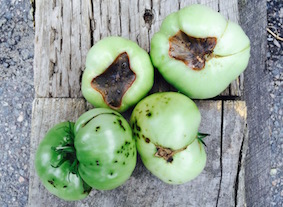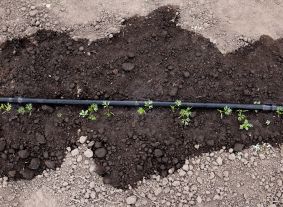Tomato Bacterial Spots and Specks
Views: 8288

Last week we discussed blossom end rot, a malady that strikes tomatoes as the green fruits begin to enlarge. It has a physiological cause—it’s not a disease that spreads from plant to plant—and giving the plants a good dose of calcium will help the subsequent fruits develop just fine. Bacterial spots and specks are different, however. These two tomato issues are caused by bacterial infections, and thus can be spread from plant to plant. Early symptoms of both bacterial spot and speck are the same: Small, 1/8-inch round dark spots appear on the tomato leaves. Over a few days these spots develop yellow halos, and the centers begin to dry. Often the older infected leaves drop off.
Spot vs. speck
Spot and speck can be differentiated on the immature fruit.
— A Spot begins as small, slightly raised spots that grow to about 1/4-inch diameter. The spots become irregular in shape, light brown, and slightly sunken. The spots eventually have a scabby appearance. The ideal conditions for the growth and spread of bacterial spot are high humidity and high temperatures (75-90F).
— Speck begins as tiny, 1/16-inch, slightly sunken black spots and do not grow larger. This flourishes in cooler (64-75F) temps and moist conditions. Speck is less common than spot.
What causes bacterial spot and speck?
Mature fruits don’t suddenly develop it.
Spot and speck are both caused by bacteria—Xanthomonas campestris pv. vesicatoria for bacterial spot and Pseudomonas syringae pv. tomato for the bacterial speck. Both can be found on infected tomato seeds and also can overwinter on infected tomato plant debris and in the soil.
It’s hard for me to tell which was the culprit for these infections popping up in my gardens. It could have been in the small tomato plants I bought at the garden center, or it could have been overwintering in the soil. If it’s the former reason, that really stinks. What I can do is be sure to remove all of the tomato plants from the garden at the end of the season.
What to do about infected tomato fruits
Both spot and speck are shallow scabby lesions. You can definitely cut or trim off the affected areas, and may even be able to scratch off the speck dots with a fingernail. The rest of the fruit should be fine. There are chemical applications (copper, actually) that are a possibility. However, they take time and are not worth the effort for a small home garden.
Here are four things that you can do to help stop the spread of these infections:
1. If only one or two plants out of many are infected, remove the entirety of the infected plants being careful not to have it in contact with non-infected tomato plants.
2. Aim your water hose at only the bottom of the plants.
3. Wash hands and disinfect your clippers after handling each tomato plant.
4. Remove diseased foliage from the area.
So, which do I have on those tomatoes in the photo above? At first I thought it was speck when the fruits were smaller, but these spots have enlarged beyond a typical speck spot. Whichever it is, I’m going to be careful in handling them.
Meet Ellen Wells
When you’re raised on a farm, you can’t help but know a thing or two about gardening. Ellen Wells is our expert on edible gardening.…
Ellen's Recent Posts

Asparagus






